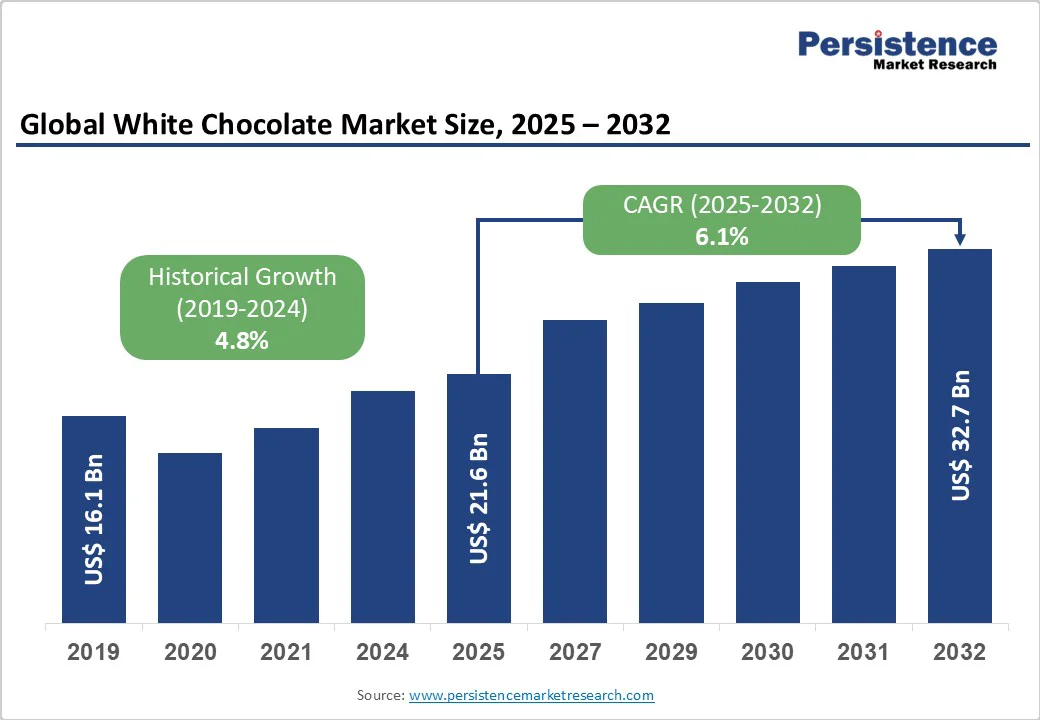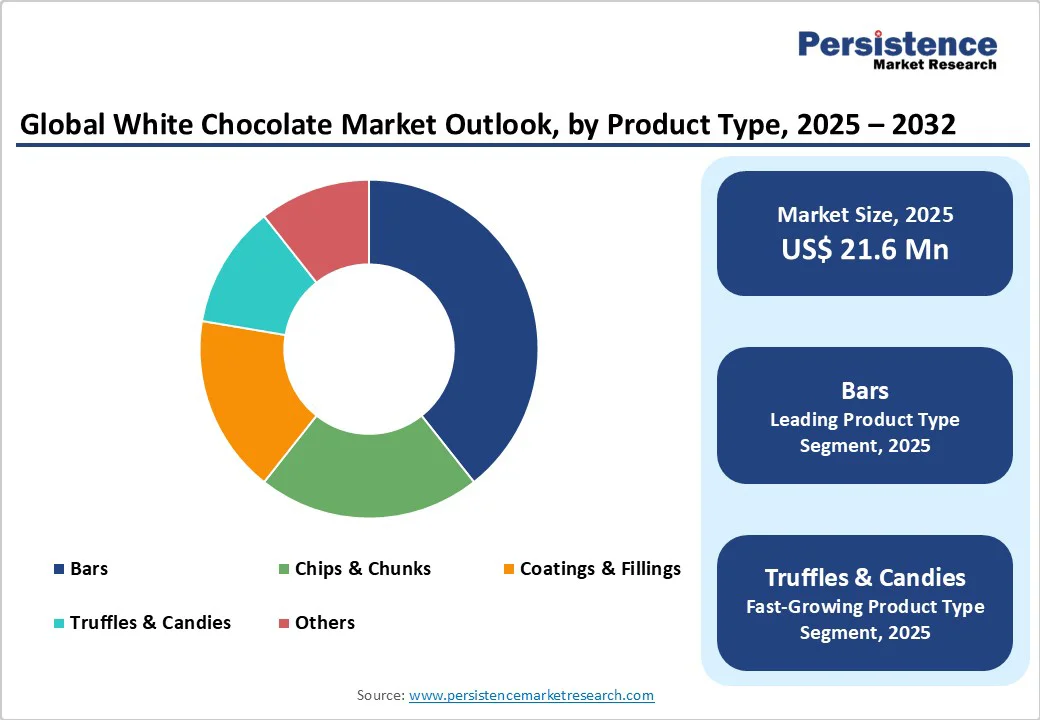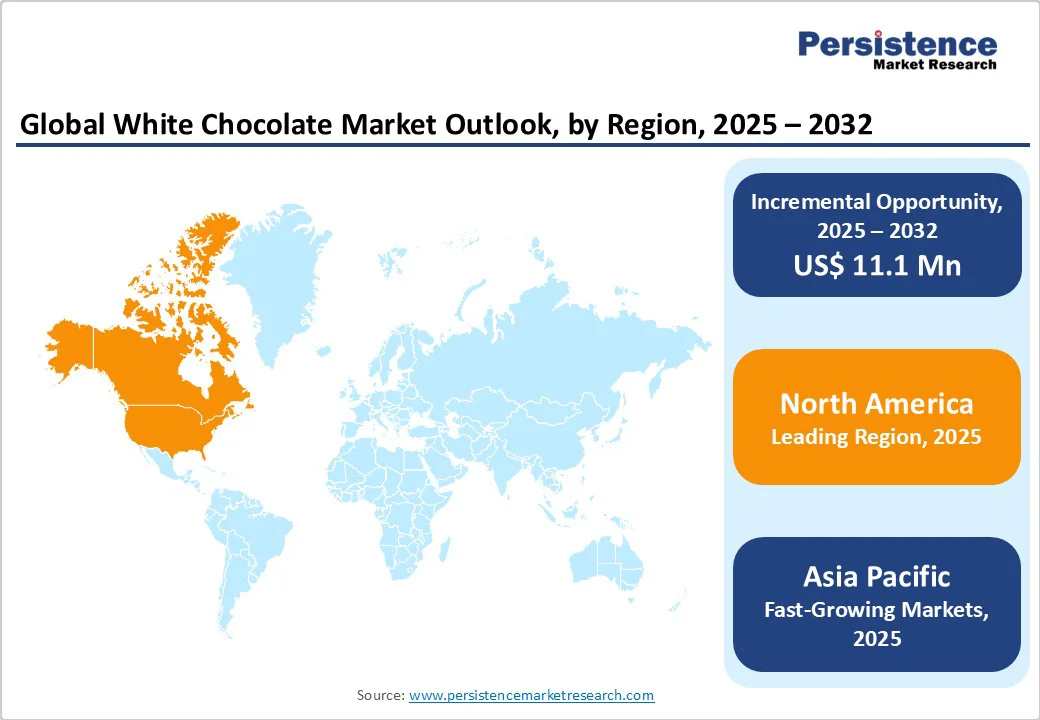ID: PMRREP22501| 219 Pages | 20 Oct 2025 | Format: PDF, Excel, PPT* | Food and Beverages

The global white chocolate market size is likely to be valued at US$21.6 Billion in 2025 and is expected to reach US$32.7 Billion by 2032, growing at a CAGR of 6.1% during the forecast period from 2025 to 2032, driven by rising consumer preference for premium confectionery and innovative dessert applications.
Unlike traditional chocolate, white chocolate’s creamy texture and mild flavor make it a popular ingredient in bakery, beverages, and dairy products. Increasing product launches with natural ingredients and unique flavors such as matcha or fruit-infused varieties are fueling demand. The expansion of e-commerce and artisanal chocolate brands is widening accessibility.
| Key Insights | Details |
|---|---|
|
White Chocolate Market Size (2025E) |
US$21.6 Bn |
|
Market Value Forecast (2032F) |
US$32.7 Bn |
|
Projected Growth (CAGR 2025 to 2032) |
6.1% |
|
Historical Market Growth (CAGR 2019 to 2024) |
4.8% |

Cocoa butter’s emollient properties are catalyzing white chocolate use in cosmetics and personal care. Lip balms, body lotions, and novelty bath products incorporating white chocolate extracts saw significant revenue growth in 2024, as reported by global regulatory filings. This cross-industry adoption not only diversifies revenue streams but also elevates white chocolate’s profile as a multifunctional ingredient, fostering collaboration between confectionery brands and beauty giants.
Its antioxidant and moisturizing qualities make it a desirable natural ingredient in skincare formulations. The rising popularity of clean-label cosmetics and consumer demand for sustainable, indulgent ingredients are further strengthening this trend. Strategic partnerships between chocolate manufacturers and beauty companies are driving co-branded innovations, expanding market reach, and reinforcing white chocolate’s premium positioning across both food and non-food industries.
White chocolate faces significant competition from dark and milk chocolate variants, which are often perceived as more versatile and nutritionally beneficial. Dark chocolate, rich in cocoa solids and antioxidants, appeals to health-conscious consumers seeking functional benefits such as heart health and improved cognitive function.
Milk chocolate, with its balanced sweetness and creamy texture, dominates mainstream confectionery preferences and enjoys broader brand recognition. This consumer bias limits white chocolate’s market penetration, as it is often considered overly sweet and lacking in “real chocolate” flavor. Consequently, manufacturers must invest heavily in marketing and product innovation to differentiate white chocolate, highlight its unique qualities, and maintain shelf space against the stronger demand and established popularity of dark and milk chocolate products.
The demand for vegan and plant-based products is rapidly reshaping the confectionery landscape, creating a significant opportunity for white chocolate manufacturers. Traditional white chocolate relies on dairy, which limits its appeal among vegan and lactose-intolerant consumers. By developing alternatives using almond, oat, soy, or coconut milk, brands can offer the same creamy texture and indulgent taste while meeting dietary preferences. These plant-based variants not only appeal to health-conscious and environmentally aware consumers but also open doors to new markets in regions with high vegan adoption.
Innovative formulations that maintain melting properties, flavor richness, and shelf life can position white chocolate as a versatile, inclusive product, driving both brand differentiation and sustainable growth in the global confectionery sector.
White chocolate bars dominate the product type segment due to their convenience, versatility, and strong consumer recognition. As ready-to-eat products, they cater to on-the-go snacking, gifting, and indulgence, making them highly accessible across age groups. Manufacturers can easily innovate with flavors, inclusions like nuts or fruit, and premium coatings, appealing to both mass-market and luxury consumers.
Their long shelf life and ease of packaging also make them ideal for retail distribution through supermarkets, convenience stores, and e-commerce platforms. White chocolate bars serve as a base for seasonal and limited-edition products, boosting repeat purchases. These factors collectively make bars the most popular and commercially viable product type within the global white chocolate market.
The solid form of white chocolate leads with a market share of 40% of the global market share in 2025, due to its convenience, versatility, and wide consumer acceptance. Ready-to-eat products such as bars, blocks, and truffles cater to on-the-go snacking, gifting, and indulgence, making them highly appealing across age groups.
Solid white chocolate also provides manufacturers with greater flexibility for flavor innovations, inclusions such as nuts or fruits, and premium packaging, enhancing its marketability. Its longer shelf life compared to liquid or powdered forms ensures easier storage, distribution, and retail presence through supermarkets, convenience stores, and e-commerce channels. Solid white chocolate serves as a base for seasonal, festive, and limited-edition products, driving repeat purchases and sustaining its dominant position in the global market.

In North America, particularly the U.S., the white chocolate market is anticipated to hold a market share of 34% in 2025, driven by evolving consumer preferences and innovative product offerings. Health-conscious and ethically minded consumers are driving demand for organic, clean-label, and sustainably sourced ingredients. Manufacturers are experimenting with unique flavor profiles, such as matcha, berries, and spices, to cater to gourmet and adventurous palates.
The rise of vegan and plant-based alternatives is expanding the market, appealing to lactose-intolerant and environmentally conscious buyers. E-commerce platforms and specialty stores are increasingly influencing purchase behavior, offering curated and seasonal white chocolate collections. These trends highlight a market that is embracing innovation, premiumization, and sustainability while adapting to shifting consumer lifestyles in the U.S.
In the Asia Pacific region, the white chocolate market is emerging rapidly, driven by rising disposable incomes, urbanization, and growing demand for premium confectionery. Countries like China, India, and Japan are witnessing increased adoption of Western-style chocolates, with white chocolate gaining popularity among younger, urban consumers.
Innovative flavors incorporating local tastes, such as matcha, tropical fruits, and nuts, are helping brands differentiate their offerings. E-commerce platforms and modern retail chains are expanding accessibility, while promotional campaigns and gifting occasions are boosting seasonal sales. Additionally, rising awareness of sustainable and ethically sourced ingredients is influencing purchasing decisions. Overall, Asia Pacific presents significant growth potential, combining rising consumer interest, localized innovation, and expanding distribution channels for white chocolate products.

The white chocolate market is highly competitive, driven by innovation, product differentiation, and evolving consumer preferences. Key players focus on introducing unique flavors, functional ingredients, and premium or ethically sourced options to attract diverse consumer segments. Market competition also emphasizes packaging innovations, seasonal or limited-edition offerings, and expansion into emerging distribution channels such as e-commerce and specialty stores
The white chocolate market size is projected to be valued at US$21.6 Bn in 2025.
The growing demand for gourmet, flavored, and luxury chocolates fuels white chocolate consumption.
The white chocolate market is poised to witness a CAGR of 6.1% between 2025 and 2032.
Infusing white chocolate with vitamins, minerals, probiotics, or antioxidants to appeal to health-conscious buyers is a key opportunity.
The key players in the white chocolate market include Mars Incorporated, Blommer Chocolate Company, Nestle SA, and Mondelez International.
| Report Attribute | Details |
|---|---|
|
Historical Data/Actuals |
2019 - 2024 |
|
Forecast Period |
2025 - 2032 |
|
Market Analysis |
Value: US$ Bn |
|
Geographical Coverage |
|
|
Segmental Coverage |
|
|
Competitive Analysis |
|
|
Report Highlights |
|
By Product Type
By Form
By Application
By Sales Channel
By Region
Delivery Timelines
For more information on this report and its delivery timelines please get in touch with our sales team.
About Author